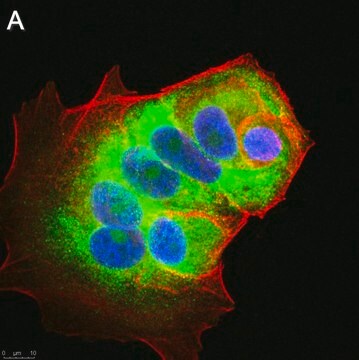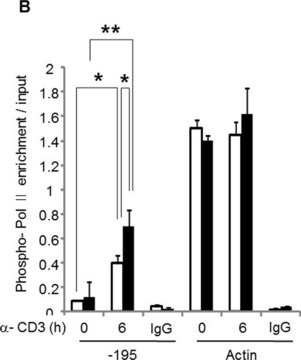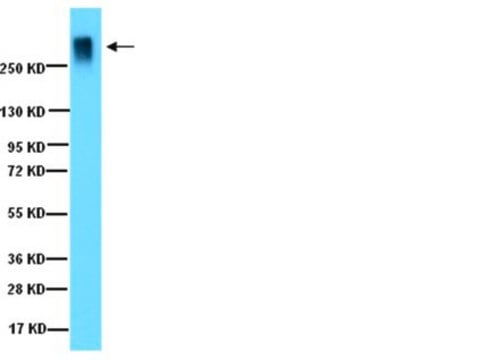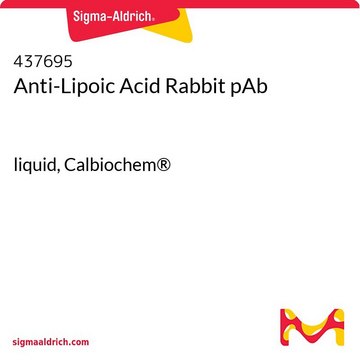추천 제품
생물학적 소스
mouse
Quality Level
항체 형태
purified antibody
항체 생산 유형
primary antibodies
클론
4H1, monoclonal
종 반응성
human
기술
immunocytochemistry: suitable
immunohistochemistry: suitable (paraffin)
immunoprecipitation (IP): suitable
western blot: suitable
동형
IgG1κ
UniProt 수납 번호
타겟 번역 후 변형
unmodified
유전자 정보
human ... L1RE1 (4029)
일반 설명
LINE-1 retrotransposable element ORF1 protein (UniProt: Q9UN81; also known L1ORF1p, LINE retrotransposable element 1, LINE1 retrotransposable element 1) is encoded by the LIRE1 (also known as LRE1) gene in human. LINE1-ORF 1P belongs to the transposase 22 family. It is mainly cytoplasmic protein and is enriched in stress granules, but may rarely be detected in the nucleolus. It contains a coiled coil domain that mediates its homotrimerization. The RNA recognition motif (RRM) the C-terminal domain are required for its proper RNA-binding activity. LINE1-ORF 1P is a nucleic acid-binding protein which is essential for retrotransposition of LINE-1 elements in the genome. It is also reported to function as a nucleic acid chaperone binding its own transcript and therefore preferentially mobilizing the transcript from which they are encoded. Retrotransposition is a shown to be a complex process that involves transcription of the LINE1, transport of its RNA to the cytoplasm, translation of the bicistronic RNA, formation of a ribonucleoprotein particle, its re-import to the nucleus and then target-primed reverse transcription at the integration site. Somatic LINE1 insertions are rare in most tissues, but are found in brain, testis, and many cancer types and have been implicated in carcinogenesis. Its expression is consistently detected in p53 mutant tumors, but, little or no expression is detected in Wilms tumors that were normal for p53. (Ref.: Goodier, JL et al. (2013). Nucleic Acids Res. 41(15): 7401-7419).
특이성
Clone 4H1 specifically detects LINE-1 ORF1 protein in MCF7 cells. This clone targets the sequence corresponding to 10 amino acids from the N-terminal region of LINE-1 ORF1p.
면역원
A linear peptide corresponding to 10 amino aicds from the N-terminal region of human LINE-1 ORF1 protein.
애플리케이션
Detect LINE-1 retrotransposable element ORF1 protein using this mouse monoclonal Anti-LINE-1 ORF1p Anibody, clone 4H1, Cat. No. MABC1152. It is used in Immunocytochemistry, Immunohistochemistry (Paraffin), Immunoprecipitation, and Western Blotting.
Immunohistochemistry Analysis: A representative lot detected LINE-1 ORF1p in Immunohistochemistry applications (Rodic, N., et. al. (2014). AM J Pathol. 184(5):1280-6; Doucet-O′Hare, T.T., et. al. (2015). Proc Natl Acad Sci USA. 112(35):E4894-900; Wylie, A., et. al. (2016). Genes Dev. 30(1):64-77).
Immunocytochemistry Analysis: A representative lot detected LINE-1 ORF1p in Immunocytochemistry applications (Taylor, M.S., et. al. (2013). Cell 155(5):1034-48).
Immunoprecipitation Analysis: A representative lot detected LINE-1 ORF1p in Immunoprecipitation applications (Taylor, M.S., et. al. (2013). Cell 155(5):1034-48).
Western Blotting Analysis: A representative lot detected LINE-1 ORF1p in Western Blotting applications (Taylor, M.S., et. al. (2013). Cell 155(5):1034-48).
Immunocytochemistry Analysis: A representative lot detected LINE-1 ORF1p in Immunocytochemistry applications (Taylor, M.S., et. al. (2013). Cell 155(5):1034-48).
Immunoprecipitation Analysis: A representative lot detected LINE-1 ORF1p in Immunoprecipitation applications (Taylor, M.S., et. al. (2013). Cell 155(5):1034-48).
Western Blotting Analysis: A representative lot detected LINE-1 ORF1p in Western Blotting applications (Taylor, M.S., et. al. (2013). Cell 155(5):1034-48).
Research Category
Apoptosis & Cancer
Apoptosis & Cancer
품질
Evaluated by Western Blotting in MCF7 cell lysate.
Western Blotting Analysis: A 1:1,000 dilution of this antibody detected LINE-1 ORF1p in 10 µg of MCF7 cell lysate.
Western Blotting Analysis: A 1:1,000 dilution of this antibody detected LINE-1 ORF1p in 10 µg of MCF7 cell lysate.
표적 설명
~42 kDa observed; 40.06 kDa calculated. Uncharacterized bands may be observed in some lysate(s).
물리적 형태
Format: Purified
Protein G purified
Purified mouse monoclonal antibody IgG1 in buffer containing 0.1 M Tris-Glycine (pH 7.4), 150 mM NaCl with 0.05% sodium azide.
저장 및 안정성
Stable for 1 year at 2-8°C from date of receipt.
기타 정보
Concentration: Please refer to lot specific datasheet.
면책조항
Unless otherwise stated in our catalog or other company documentation accompanying the product(s), our products are intended for research use only and are not to be used for any other purpose, which includes but is not limited to, unauthorized commercial uses, in vitro diagnostic uses, ex vivo or in vivo therapeutic uses or any type of consumption or application to humans or animals.
적합한 제품을 찾을 수 없으신가요?
당사의 제품 선택기 도구.을(를) 시도해 보세요.
Storage Class Code
12 - Non Combustible Liquids
WGK
WGK 1
Flash Point (°F)
Not applicable
Flash Point (°C)
Not applicable
시험 성적서(COA)
제품의 로트/배치 번호를 입력하여 시험 성적서(COA)을 검색하십시오. 로트 및 배치 번호는 제품 라벨에 있는 ‘로트’ 또는 ‘배치’라는 용어 뒤에서 찾을 수 있습니다.
Adam Idica et al.
The Journal of biological chemistry, 292(50), 20494-20508 (2017-10-05)
Repetitive elements, including LINE-1 (L1), comprise approximately half of the human genome. These elements can potentially destabilize the genome by initiating their own replication and reintegration into new sites (retrotransposition). In somatic cells, transcription of L1 elements is repressed by
John L Goodier et al.
Acta neuropathologica communications, 8(1), 110-110 (2020-07-18)
A pathogenic GGGCCC hexanucleotide expansion in the first intron/promoter region of the C9orf72 gene is the most common mutation associated with amyotrophic lateral sclerosis (ALS). The C9orf72 gene product forms a complex with SMCR8 (Smith-Magenis Syndrome Chromosome Region, Candidate 8)
Patcharawalai Whongsiri et al.
International journal of molecular sciences, 21(24) (2020-12-17)
Human genomes contain about 100,000 LINE-1 (L1) retroelements, of which more than 100 are intact. L1s are normally tightly controlled by epigenetic mechanisms, which often fail in cancer. In bladder urothelial carcinoma (UC), particularly, L1s become DNA-hypomethylated, expressed and contribute
Daniel Ardeljan et al.
Clinical chemistry, 63(4), 816-822 (2017-02-12)
A large portion of intronic and intergenic space in our genome consists of repeated sequences. One of the most prevalent is the long interspersed element-1 (LINE-1, L1) mobile DNA. LINE-1 is rightly receiving increasing interest as a cancer biomarker. Intact
Erica M Briggs et al.
Mobile DNA, 12(1), 21-21 (2021-08-25)
The autonomous retroelement Long Interspersed Element-1 (LINE-1) mobilizes though a copy and paste mechanism using an RNA intermediate (retrotransposition). Throughout human evolution, around 500,000 LINE-1 sequences have accumulated in the genome. Most of these sequences belong to ancestral LINE-1 subfamilies
자사의 과학자팀은 생명 과학, 재료 과학, 화학 합성, 크로마토그래피, 분석 및 기타 많은 영역을 포함한 모든 과학 분야에 경험이 있습니다..
고객지원팀으로 연락바랍니다.








